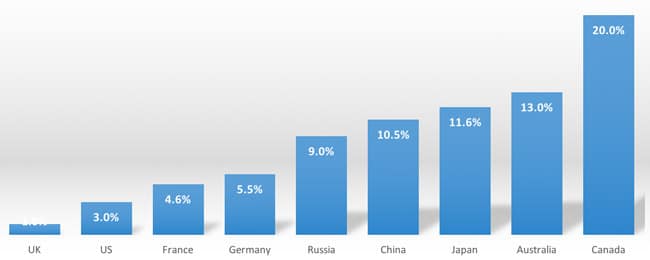Up and down the table: Growth trends across major international study destinations
The past few years have been a period of increasing dynamism in the international education sector, as the following factors have combined to influence both the ability of study destinations to attract students and the choices made by students when planning to study abroad:
- Immigration policies
- Increased (or decreased) government support allocated to the sector in some countries
- A surge in nationalism and/or anti-immigrant sentiment in some countries
- The political climate in both the UK and the US
- Growing higher education capacity in some sending countries
- The emergence of important regional study destinations
- Intensifying safety concerns among students
- More options for students to “study abroad” while not leaving home (e.g., MOOCs, transnational education, online and distance education)
As we began to examine more closely last year, these same factors are leading to some notable changes in the table of leading international study destinations.

Canada
The virtually flat growth occurring in the US and UK is also a consequence of other countries ramping up their offer to international students. Canada, which recorded international student enrolment growth of 20% in 2017 (and 41% in the period 2015–2017), offers attractive work and permanent residency opportunities to students wanting to stay and is increasingly seen as one of the safer countries in which to study abroad. In 2018, it offers serious competition to the US on the basis of value for price, reputation for safety, and a welcoming political and social environment. Canada is becoming increasingly attractive in the important sending markets of India and Vietnam, not to mention Iran and Bangladesh. Canada’s international student enrolment target was to reach 450,000 students by 2022, and, as of 2017, it had already met that goal with 494,000 foreign students enrolled.
Australia
In Australia, international enrolment reached a new high in 2017, with 13% growth over the year before and a total count of 624,000 foreign students. Australia is now the second-most popular destination for university-aged students from China and India and boasts significant numbers from other Asian markets such as South Korea, Vietnam, and Thailand. One higher education analyst predicts that foreign enrolment in Australian higher education will exceed that of the UK’s by 2019 if growth trends for the two countries continue. Like Canada, Australia is competing on its reputation for safety and educational quality while its proximity to Asian markets is also a definite advantage. The country’s international enrolment target is 720,000 students by 2025, and it is well on track to reach that goal. For several years, the Australian government has been a strong supporter of the sector, with international education identified as one of five “super growth sectors that will help complete Australia’s transition from a resource-based economy to a modern services and knowledge economy.”
China
China, meanwhile, has grown quickly to become the world’s fifth leading study destination. A total of 489,200 international students enrolled in Chinese institutions and schools in 2017. This represents an increase of 10.5% over 2016, and puts the country well within reach of its longer-term goal to host 500,000 students by 2020. The growing profile of China’s leading institutions, an expanding scholarship scheme (especially for students enrolling in degree programmes), the powerful Chinese economy, and the relative affordability of Chinese higher education have been notable factors in China’s growing share of the world’s international students. Top sending countries for China in 2017 included South Korea, Thailand, Pakistan, the United States, India, Russia, Japan, Indonesia, Kazakhstan, and Laos. Nearly two-thirds of all foreign students in the country (65%) come from markets targeted by China’s “One Belt, One Road Initiative,” a massive trade and foreign investment programme linking markets along the traditional Silk Road trade routes throughout Asia and Europe. “As of the end of 2017, China was the most popular destination for international students in Asia,” notes a statement from China’s Ministry of Education.
Japan
Another Asian country is posting impressive growth as well: Japan, where international student numbers have grown for five consecutive years. As of May 2017, 267,040 foreign students were studying in the country, an increase of 11.6% over 2016, according to the Japan Student Services Organization (JASSO). Japan’s goal is to host 300,000 international students by 2020, and it may reach that target by late 2018 or early 2019 if the current growth trend continues. China and Vietnam continue to be the major senders of international students to Japan – though there has been significant growth stemming from several other markets including Sri Lanka, Indonesia, and Myanmar – and all the top ten source markets for Japan are within the Asian region. Japan’s success in increasing its foreign enrolments is due to a number of factors, but particularly interesting has been the country’s astute understanding that international students put employability high on their list of goals when they decide where to study. The Japanese government has for some time been supporting subsidised company internships, help with finding jobs on graduation, additional Japanese language courses, and more streamlined processes for work visas to international students.
Germany
The goal was to enroll 350,000 international students by 2020, but Germany has already exceeded the target as official statistics confirm that 358,900 foreign students were studying in German universities in 2017, a 5.5% increase over the previous year. Germany is now the world’s sixth leading study destination worldwide, after the US, the UK, Australia, Canada, and China. China remains by far the most important source market for Germany, sending 35,000 students in 2017 and contributing growth of 8.5%. The number of Indian students in Germany grew even more robustly (13%) and in 2017, Germany’s universities enrolled 13,540 Indian students. Iran, the US, Korea, Pakistan, Syria, and Tunisia also sent notably more students to Germany in 2017 than in 2016, while Russia, Germany’s third most important source market, sent fewer. Within the past few years alone, Germany’s international recruitment efforts have been boosted by a no-tuition policy for international students, improved opportunities for work during studies and after graduation, and the continuing expansion of English-taught programmes within German universities.
France
International enrolments in France are growing more modestly, with a growth trend closer to that of the UK than to those in other major destinations including Germany, Canada, China, and Australia. As of 2016, the last year for which data was released, there was a year-over-year increase of 4.6% and the country hosted 325,000 foreign students. While numbers continue to go up in France – with a combined growth of just over 12% between 2012 and 2016 – the country’s market share has been slipping over the past several years. Africa remains the home of France’s most important education export markets. More than four in ten of all foreign students in France come from Africa and the continent has provided some of the most important drivers of French enrolment growth over the last five years (including Morocco with 15% growth since 2010/11, Congo at +24%, and Côte d’Ivoire at +50%). France’s notable non-African growth markets are largely found in Europe. They include Italy, Spain, Portugal, Belgium, and the UK. France has a stated goal to build its international student base to 20% of total higher education enrolment by 2025. This would mean enrolling about 470,000 international students based on current levels.
Russia
Russia, which is roughly tied with France in terms of market share of international students (around 6% as of 2016) has a new international recruitment programme designed to dramatically expand foreign enrolments in its higher education institutions from just under 220,000 students today to nearly 310,000 by 2020 (a 40% increase) and 710,000 students by 2025. The population of foreign students at Russian universities has grown by an average annual rate of 9% since 2003, with most coming from the former Soviet Republics that now make up the Commonwealth of Independent States (CIS). Russia intends to strengthen its competitive offer by means of strengthened support services for international students; expanded English-medium degree programmes; and more joint programmes, pathway options, summer programmes, and online programmes. The strategy also anticipates greater coordination of Russian recruitment efforts through marketing campaigns, education fairs, and also through a new online portal promoting Russian education. For additional background, please see:














